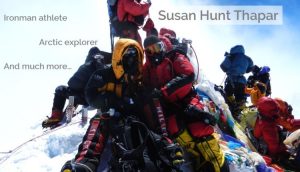Categories
My Journey to Everest & Beyond – Susan Hunt Thapar
Mar 08, 2018
When I rang my mother to let her know that I had summited Mt Everest and arrived back at Base Camp with all fingers and toes intact, I could tell from her the quiver in her voice that I had really gone TOO far this time. It was 2011 and I was 53 years old. To be fair to my mother, I have put her through a lot over the years. She can’t explain why her perfectly normal, middle-class daughter should have found herself in so many perilous and precarious positions.
I’m not sure she would have found much succor either if she had read British mountaineer George Mallory’s quote on the nature of the danger.
“But when I say our sport is a hazardous one, I do not mean that when we climb mountains there is a large chance we will be killed, but that we are surrounded by dangers which will kill us if we let them.”
Let me paint the picture for you of my journey to the top of the world.
THE AQUATIC YEARS
I grew up in Australia, an island continent where every child learns to swim before they can walk. When my father threw me in the pool at the age of two and a half, I learned the first of many important lessons which would stand me in good stead on the Everest — “Sink or swim!”
Most of my early adventures took place in or on the water. Not a very auspicious beginning for a mountaineer.
Australia’s 36,000 kilometers of mainland coastline is a great playground but it also has treacherous surf, and many of its urban beaches are patrolled by surf lifesavers.
Bondi SLSC
Bondi Beach is one of the most famous and it is patrolled by a mix of sun-bronzed, muscular, professional lifeguards and a motley crew of volunteers – I was one of the latter. It was a great way to spend summer weekends, competing in surf swimming competitions, clearing the beach in the event of a shark alarm and trying to save hapless backpackers caught in riptides and finding themselves heading towards New Zealand.
Maui Channel Swim
Long distance swimming became a bit of a passion. The Maui Channel Swim is the longest, open water relay swim race in the world dating to 1972. The 9.5-mile channel swim starts on the island of Lanai and crosses the Auau Channel to the island of Maui in Hawaii. This channel is one of the deepest in the world, notorious for its swift currents.
There are six swimmers per team and each swimmer swims half-hour stages until all team members have raced. Then each swimmer swims a 10-minute stage until they cross the finish line. Every team has a dedicated escort boat and captain who acts as the navigator and is critical to the teams’ success.
One recent year’s event suffered from ocean swells of six feet and higher almost the entire way. Early on, swimmers were pulled from the water due to a circling 12- to 15-foot tiger shark, the second time in three years a predatory shark impacted the race.
Other Aquatic Adventures.
Other aquatic adventures over the years included the Hawkesbury Challenge – a 111 km overnight kayaking race – sort of like a fun run on water. Australians do some very strange things.
THE TRIATHLON YEARS
When I turned 30 I decided I needed a new challenge. This coincided with the birth of triathlons in Australia so I threw myself in head first.
As you may be aware, a triathlon is a multi-sport race of swimming, followed by a run followed by a bicycle section, with distances ranging from short to extra-long.
I did my first mini-triathlon (about an hour) and a year later successfully completed the longest of them all, the Ironman.
When I crossed the finish line over 12.5 hours later after swimming 3.8km, cycling 180kms and running a full marathon (42.2 km) I was feeling no pain (at least until I tried to walk up the stairs the next day). But what I did learn were two things very important for the Everest attempt.
The first was the importance of visualization (I was sure I would get to the end of the race the same way I had “seen” myself on top of the mountain.)
The second was to never give up. In the words of one of the most famous Ironman triathletes Dave Scott, “Don’t pull out unless you are dead!”
Triathlon World Championships
Having proved to myself I could keep going a very long way, I spent the next ten years trying to get faster over various distances. After ten years of significant investment in wetsuits, bikes, running shoes, coaching and physiotherapists, I managed to qualify and compete in two World Triathlon championships in Cancun Mexico and
Wellington New Zealand.
Two more valuable lessons were learned.
The need for (and the joy of) technology and;
The apparent need for vast amounts of expensive kit! I need to hold a garage sale for all the gear I purchased for the Everest attempt.
THE ADVENTURE RACING YEARS
It seemed (to me at least) to be a logical transition from triathlons to adventure racing — a combination of two or more endurance disciplines such as trekking, mountain running, kayaking, mountain biking, climbing, done contiguously with no scheduled time for sleeping and generally self-supporting and navigated.
Keeping with my general foolhardy philosophy of life, I decided to go big or go home! I was invited to participate in the granddaddy of all adventure races, the Eco-Challenge in Borneo in 2000 with a team of 3 large Aussie blokes. That was my first mistake. To quote from the organizers website: “The 2000 Eco-Challenge expedition race in Sabah Borneo is a multi-sport expedition race which includes rappelling treacherous canyon walls, caving with fixed ropes, jungle trekking, ocean paddling, sailing in indigenous Perahu Outrigger canoes, canoeing in native sampan canoes in unpredictable mountain streams, swimming and scuba diving in dangerous waters and mountain biking over brutal landscapes for a total distance of 500 km”..
mmmm sounds like my kind of holiday!
There were dangers aplenty alright. But what they didn’t warn me about was how to deal with three monosyllabic, alpha males who communicated mainly through grunts and with whom I would live and push myself to the limit over ten days in a harsh environment.
Another Everest lesson: Choose your teammates very carefully
But there were some other lessons as well.
It’s never too late to learn new skills (I was 42 the first time I sat on a mountain bike) and the human body can withstand a lot more abuse than we give it credit for.
THE CLIMBING YEARS
I first started climbing as part of adventure race training, and it developed into a full-blown obsession when I moved to the UK away from my beloved Australian beaches to Manchester – a city blessed with the Lake District on one side and the other famous climbing areas of the Peak District and Scotland on the others.
Ski Mountaineering
My first real forays into the mountains were on skis, off-piste. Not only was I new to mountains I had never skied before either. Enter my friend Tim Pettifer, climber, ski instructor extraordinaire and Scots madman whose favorite expression is “feel the fear and do it anyway” (another good Everest lesson).
Ice Climbing Rjukan
I soon discovered the joys of ice climbing and this picture is taken in Rjukan in Norway, famous for its frozen waterfalls many hundreds of feet long. It is also famous for having been the center of a fierce WW2 battle when the allies bombed the heavy water power plant from which Hitler was trying to extract the deuterium used in the production of nuclear weapons (as featured in the film Telemark Heroes). If you look carefully at the photograph you’ll see embedded in this fairy tale winter landscape, pieces of bombed metal wherever one turns. Ama Dablam
After several climbing trips to the French Alps I decided to cut my teeth on something bigger.
Ama Dablam, a mountain the Himalayan range in eastern Nepal, is considered to be one of the prettiest in the world. It’s named after the hanging glacier on the South West face resembling a “Dablam” or charm box in Tibetan. The word “Ama” means mother and you can see her “encircling” arms. Although it is only 6812 meters, it is considered to be the toughest and most technical of the so-called “trekking peaks” requiring steep ice, snow, and rock climbing. The big lesson I learned on Ama, having turned back 150 meters from the summit is that getting to the top is only half the journey. Having lost time due to Acute Mountain Sickness, I chose to turn around at a responsible time and travel down safely under my own steam rather than rely on being hauled down by one of our wonderful sherpas.
EVEREST
And to Everest. One of the many questions I am often asked is “how did you train?”
I confess I had a very unusual training regime as it involved planning for and getting married three months before the departure date.
Straight after the wedding, I traveled to Scotland to meet up with my new Everest teammates where we practiced our rope work, ice climbing, and ladder crossings.
While other expeditions travel straight to Base Camp, our team of six instead spent three glorious weeks trekking through the Thame Valley and over the three highest passes in the region – Renjo La, Cho la and the Kongma La before summiting Pokhalde (5,800m) as our acclimatization peak. It also gave us a great chance to bond as a group. As we came into Base Camp on a grey, cold, snowy day through the underwhelming scree slopes, the reality of what I had taken on dawned on me.
The Everest Journey
The traditional route up the South East Ridge which is more or less the same as when Sir Edmund Hillary and Tenzing Norga made the first summit in 1953…
Pictures tell a better story than words (Do read the captions below). Here is a brief graphic description of my journey to the top of the world.
MARATHON DES SABLES
My husband very sensibly banned me from climbing any more 8,000 meters plus mountains and so I started looking for new challenges.
An obvious one at sea level was the Marathon des Sables: a 240 kilometer run through the Sahara desert in Morocco, completely self-sufficient i.e. carrying all one’s own gear, except for water, over seven days.
The organisers provided water over the course (much needed when the temps hit 50 degrees) and a tarpaulin tent to share with seven other unfortunate runners.
Running an average of a marathon a day (and a double marathon of 80kms on one of the days) was hard. However, the scenery and the camaraderie made it an extraordinary experience.
I am often asked, “what next?”
I try not to define myself solely by the adventures in my life. That said, there are goals and bucket list items that I have yet to tick off.
Watch this space. However, I suspect there will be a lot of water between me and my next goal!







